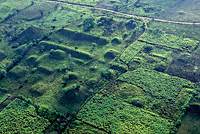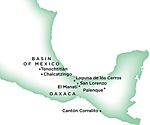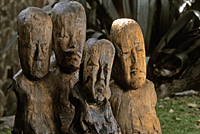

Posted on 04/06/2007 2:19:37 PM PDT by blam
Beyond the Family Feud
Volume 60 Number 2, March/April 2007
by Andrew Lawler
After decades of debate, are younger scholars finally asking the right questions about the Olmec?


The lush, wet environment of the Laguna de los Cerros site, aerial view above left, typifies the Olmec heartland between the later Aztec (Tenochtitlán) and Maya (Palenque) regions. (Ken Garrett)
It's a drizzly autumn morning in the eastern Mexican city of Xalapa, near the heartland of what many scholars say was Mesoamerica's first civilization. At the city's elegant anthropology museum, amid one of the finest Olmec collections in the world, Yale archaeologist Michael Coe points at the giant squat stone head staring sullenly at us. "Look at this," he says enthusiastically. "When it was made, the Maya area didn't even have pottery, and the biggest sculpture from this time in Oaxaca"--an important valley to the west--"could fit in this guy's eye." The Olmec, Coe insists, "were the Sumerians of the New World."

More than 40 wooden busts were found buried at El Manatí, an early Olmec religious site. The faces vary and may represent individual people rather than deities. (Ken Garrett)
An energetic man even at 77, he is part of an older generation of scholars who have spent a good part of their professional lives arguing among themselves over whether the Olmec birthed the rudiments of Mesoamerican civilization, or whether they were one among many contemporary peoples who contributed art, technology, and religious beliefs to the Aztec, Maya, and other cultures that Cortes and the Spanish encountered 2,500 years later.
But that lingering "mother-sister" debate--often vociferous, occasionally unseemly, and sometimes downright nasty--obscures a quiet revolution in research on early Mesoamerica.
While the elders bicker, a younger batch of archaeologists is pursuing other questions, asking, for example, how the ordinary Olmec lived and worked, and what they ate.
Such fundamental matters until now were largely neglected amid the academic fracas, which has focused on monumental structures, evidence of kings, and the iconography of the elite. "Everyone is flying a flag from their own valley," sighs Mary Pye, a 40-something archaeologist in Mexico City who is also in Xalapa for a conference on the Olmec. "Forget mother-sister," she says. "It's more complicated."
The more nuanced picture emerging of early Mesoamerica does not fit that of either warring camp. Those who back the Olmec as the first civilization traditionally point to the early adoption of maize, the growth of urban centers, and the export of finished goods such as pottery throughout Mesoamerica to clinch their argument.
Opponents emphasize the complexity of other cultures in different areas, such as Oaxaca. But the new research shows that during the early critical phase of urbanization the Olmec may have shunned maize, lived mostly as fishermen, and sought luxury items from distant places, while simultaneously expanding their cultural influence throughout the region.
Andrew Lawler is a staff writer for Science and lives in rural Maine.
Olmecs In Pre-Colombian America
(Mucho pictures)
Professor Digs For Clues To Our Survival
University Of British Columbia | 4-5-2007 | Lorraine Chan
Posted on 04/06/2007 4:36:32 PM EDT by blam
http://www.freerepublic.com/focus/f-news/1813276/posts
Please FREEPMAIL me if you want on or off the
"Gods, Graves, Glyphs" PING list or GGG weekly digest
-- Archaeology/Anthropology/Ancient Cultures/Artifacts/Antiquities, etc.
Gods, Graves, Glyphs (alpha order)
thanks.
they look like euros.


Here's one that I have problems associating with Olmecs. And, somewhere I have one that looks like a Rabbi.
There are 257 images according to the above index.

How beautiful is that?
Is there any clue as to the obviously African features of some of these figures illustrated here?
Probably African.

This is Luzia, the 2nd oldest skeleton ever found in the Americas at 11,500 years old...found in Brazil.
|
|
|||
Gods |
Just updating the GGG info, not sending a general distribution. |
||
|
· Mirabilis · Texas AM Anthropology News · Yahoo Anthro & Archaeo · · History or Science & Nature Podcasts · Excerpt, or Link only? · cgk's list of ping lists · |
|||
Disclaimer: Opinions posted on Free Republic are those of the individual posters and do not necessarily represent the opinion of Free Republic or its management. All materials posted herein are protected by copyright law and the exemption for fair use of copyrighted works.